The concept of a discrete category called American Indian Art is a western concept which was refined during the twentieth century. Traditionally, American Indians had improved the aesthetics of the things they made, but they did not conceptualize art as something separate from function. In his book Native Arts of North America, Christian Feest writes:
“None of the native languages of North America seem to contain a word that can be regarded as synonymous with the Western concept of art, which is usually seen as something separable from the rest of daily life.”
During the first part of the twentieth century, Indian art was being driven by a market demand outside of the tribes. Indian artists were not only selling things which would be classified as art to non-tribal members, they were also creating things specifically for this market.
One of the important market forces was tourism. As tourists encountered Indians, they wanted to buy souvenirs and the Indians, in response to market demand, began to make traditional items not for tribal use, but for sale to the tourists. As with any entrepreneurial enterprise, the Indian craftspeople paid attention to what sold and what did not and thus they began to make more of the items which sold well. In addition, non-Indian traders who sold Indian crafts often made suggestions regarding designs, styles, and colors. Thus, the non-Indian tourist stereotypes of what was Indian and what was not began to shape the Indian art market.
This tourist oriented Indian art market is what Christian Feest calls ethnic art. According to Christian Feest:
“Ethnic art was (and is) produced by members of tribal societies primarily for the use of members of other groups, in the case of North America mainly for White Americans. It is generally not thought of as art by its makers, who still live in a social context that does not recognize art as something separate.”
Christian Feest also writes:
“The maker of ethnic art often does not know why his products are bought and what possible use the buyer may make of them. For himself they are first of all a source of income; in the long run they may become an important symbol of the makers’ ethnic identity.”
Briefly described below are a few of the events regarding American Indian art in 1918.
Navajo
To illustrate the songs used in their ceremonies, the Navajo use sandpaintings or drypaintings. These are created by dribbling colors (made from charcoal and pulverized minerals) on the ground using the thumb and first finger of the right hand. Traditionally, the sandpainting is destroyed at the conclusion of the ceremony.
Navajo sandpaintings made by Sam Chief (Yellow Singer) at the Arizona State Museum in Tucson, Arizona became the first sandpaintings which were not destroyed at the end of the day and were allowed to remain as a part of a permanent museum collection. According to anthropologist Nancy Parezo, in her book Navajo Sandpainting: From Religious Act to Commercial Art:
“This was an important step in the transition which would allow commercial sandpainting to be developed.”
Pueblos
San Ildefonso potters María and Julian Martinez began to develop a black-on-black pottery. Rick Dillingham, in his essay in I Am Here: Two Thousand Years of Southwest Indian Arts and Culture, writes:
“The Black-on-black technique involves an initial overall polishing of the vessel with red slip. Then, using a thinned mixture of slip, designs are painted over the polished surface. Before the firing the jar is a matte red-brown on polished red, and after the firing the more recognizable matte and polished black.”
This pottery helped to create a growing market for Pueblo pottery.
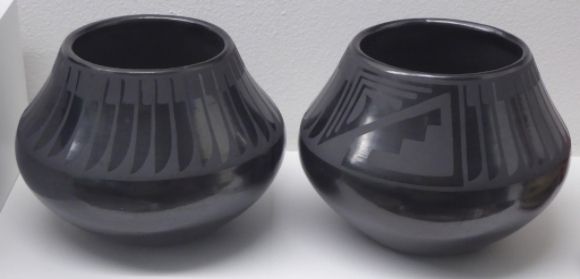 Shown above are blackware jars by María Martinez (1887-1980) and Santana Roybal Martinez (1909-2002) (jar on left) and María Martinez and Popovi Da (1923-1971) (jar on right). These are on display in the Maryhill Museum of Art.
Shown above are blackware jars by María Martinez (1887-1980) and Santana Roybal Martinez (1909-2002) (jar on left) and María Martinez and Popovi Da (1923-1971) (jar on right). These are on display in the Maryhill Museum of Art. 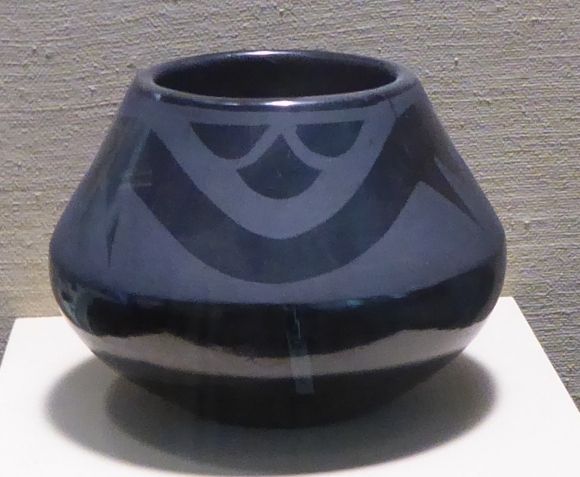 Shown above is a bowl by María and Jose Martinez on display in the Portland Art Museum.
Shown above is a bowl by María and Jose Martinez on display in the Portland Art Museum. 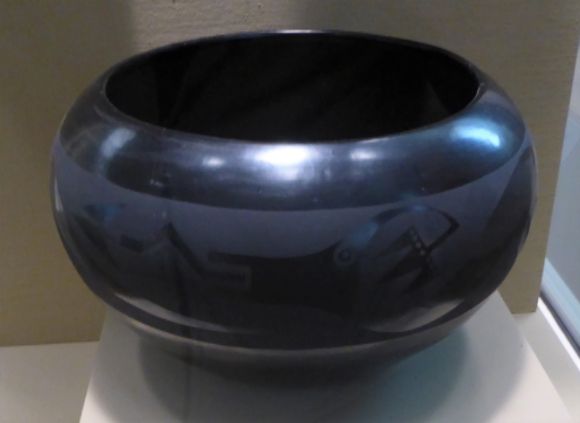 Shown above is a bowl by María Martinez on display in the Portland Art Museum.
Shown above is a bowl by María Martinez on display in the Portland Art Museum. 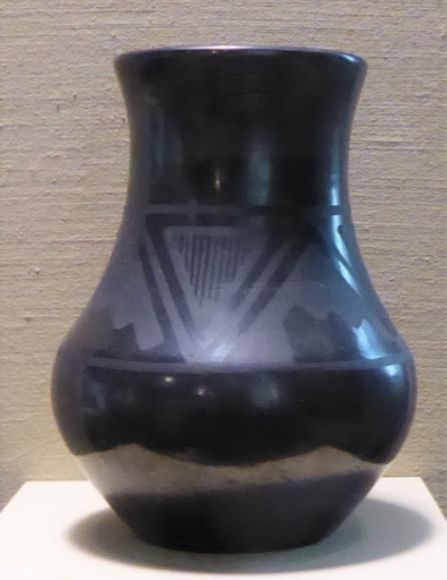 Shown above is a bowl by María Martinez on display in the Portland Art Museum.
Shown above is a bowl by María Martinez on display in the Portland Art Museum.
In New Mexico, San Ildefonso artist Crescencio Martinez died of influenza at the age of 39. He is considered to be the founder of contemporary Indian painting. According to Edwin Wade of the Museum of Northern Arizona, in an article in American Indian Art:
“Martinez expanded his artistic horizon from that of a decorator of ceramics to a figurative illustrator with a growing popular audience.”
Pan-Indian Art
As the market for Indian Ethnic Art increased, by both private collectors and museums, a type of Pan-Indian Art developed. Christian Feest explains:
“Pan-Indian art is produced by native Americans who feel themselves no longer exclusively bound to the values and customs of their original tribal society. They work for the art market of the dominant White society and consequently regard themselves as artists.”
Christian Feest goes on to write:
“While still drawing on the experience of their specific cultural background, their style is no longer unique to the tribe, but is largely shaped by White expectations about ‘Indian style.’”
The development of pan-Indian art in 1918 came from two different centers: New Mexico and Oklahoma.
In Santa Fe, New Mexico, Elizabeth De Huff, the wife of the superintendent of the U.S. Indian School, conducted watercolor classes in her home for a number of Pueblo students, including Velino Herrera, Fred Kabotie, and Otis Pololonema. Her support for the Pueblo students was condemned by non-Indians and her husband was transferred to another position.
In Oklahoma, young Kiowa students at the St. Patrick Mission Day School began painting. Their works were sold in Taos, New Mexico and the students – Stephen Mopope, Spencer Asah, Jack Hokeah, Monroe Tsatoke, and Lois Bougetah Smokey – became known in the art world as the Kiowa Five. All were from important Kiowa families.
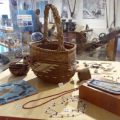
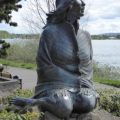
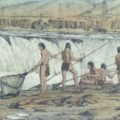
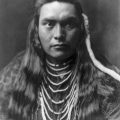
Leave a Reply